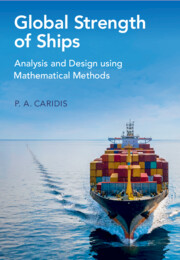Refine search
Actions for selected content:
5487 results in Thermal-fluids engineering
11 - Aspects of Uncertainty
-
- Book:
- Global Strength of Ships
- Published online:
- 20 March 2025
- Print publication:
- 03 April 2025, pp 513-558
-
- Chapter
- Export citation
Appendix C - Rule Hull Girder Torsional Strength
-
- Book:
- Global Strength of Ships
- Published online:
- 20 March 2025
- Print publication:
- 03 April 2025, pp 756-762
-
- Chapter
- Export citation
Contents
-
- Book:
- Global Strength of Ships
- Published online:
- 20 March 2025
- Print publication:
- 03 April 2025, pp vii-xii
-
- Chapter
- Export citation
Abbreviations
-
- Book:
- Global Strength of Ships
- Published online:
- 20 March 2025
- Print publication:
- 03 April 2025, pp xvii-xxii
-
- Chapter
- Export citation
7 - Nonlinear Response to Primary Loading
-
- Book:
- Global Strength of Ships
- Published online:
- 20 March 2025
- Print publication:
- 03 April 2025, pp 298-344
-
- Chapter
- Export citation
Appendix E - Orthogonality and the Modal Analysis of Structures
-
- Book:
- Global Strength of Ships
- Published online:
- 20 March 2025
- Print publication:
- 03 April 2025, pp 773-779
-
- Chapter
- Export citation

Global Strength of Ships
- Analysis and Design using Mathematical Methods
-
- Published online:
- 20 March 2025
- Print publication:
- 03 April 2025
Contents
-
- Book:
- Coarse Graining Turbulence
- Published online:
- 31 January 2025
- Print publication:
- 06 February 2025, pp v-xi
-
- Chapter
- Export citation
8 - Verification, Validation, Uncertainty Quantification, and Coarse-Graining
- from Part I - Paradigms and Tools
-
-
- Book:
- Coarse Graining Turbulence
- Published online:
- 31 January 2025
- Print publication:
- 06 February 2025, pp 222-260
-
- Chapter
- Export citation
14 - High-Order Simulations of Supersonic Combustion
- from Part II - Challenges
-
-
- Book:
- Coarse Graining Turbulence
- Published online:
- 31 January 2025
- Print publication:
- 06 February 2025, pp 419-454
-
- Chapter
- Export citation
7 - Data-Driven Modeling for Coarse Graining
- from Part I - Paradigms and Tools
-
-
- Book:
- Coarse Graining Turbulence
- Published online:
- 31 January 2025
- Print publication:
- 06 February 2025, pp 202-221
-
- Chapter
- Export citation
17 - Firestorms, Fallout, and Atmospheric Turbulence Induced by a Nuclear Detonation
- from Part II - Challenges
-
-
- Book:
- Coarse Graining Turbulence
- Published online:
- 31 January 2025
- Print publication:
- 06 February 2025, pp 525-549
-
- Chapter
- Export citation
15 - Coarse-Graining Supersonic Combustion
- from Part II - Challenges
-
-
- Book:
- Coarse Graining Turbulence
- Published online:
- 31 January 2025
- Print publication:
- 06 February 2025, pp 455-493
-
- Chapter
- Export citation
Part II - Challenges
-
- Book:
- Coarse Graining Turbulence
- Published online:
- 31 January 2025
- Print publication:
- 06 February 2025, pp 261-262
-
- Chapter
- Export citation
Epilogue
-
- Book:
- Coarse Graining Turbulence
- Published online:
- 31 January 2025
- Print publication:
- 06 February 2025, pp 550-558
-
- Chapter
- Export citation
10 - Wall-Bounded Turbulence
- from Part II - Challenges
-
-
- Book:
- Coarse Graining Turbulence
- Published online:
- 31 January 2025
- Print publication:
- 06 February 2025, pp 306-332
-
- Chapter
- Export citation
Part I - Paradigms and Tools
-
- Book:
- Coarse Graining Turbulence
- Published online:
- 31 January 2025
- Print publication:
- 06 February 2025, pp 3-4
-
- Chapter
- Export citation
Prologue
-
- Book:
- Coarse Graining Turbulence
- Published online:
- 31 January 2025
- Print publication:
- 06 February 2025, pp 1-2
-
- Chapter
- Export citation
5 - Symmetries, Subgrid-Scale Modeling, and Coarse Graining
- from Part I - Paradigms and Tools
-
-
- Book:
- Coarse Graining Turbulence
- Published online:
- 31 January 2025
- Print publication:
- 06 February 2025, pp 151-176
-
- Chapter
- Export citation
9 - Transition to Turbulence
- from Part II - Challenges
-
-
- Book:
- Coarse Graining Turbulence
- Published online:
- 31 January 2025
- Print publication:
- 06 February 2025, pp 263-305
-
- Chapter
- Export citation
